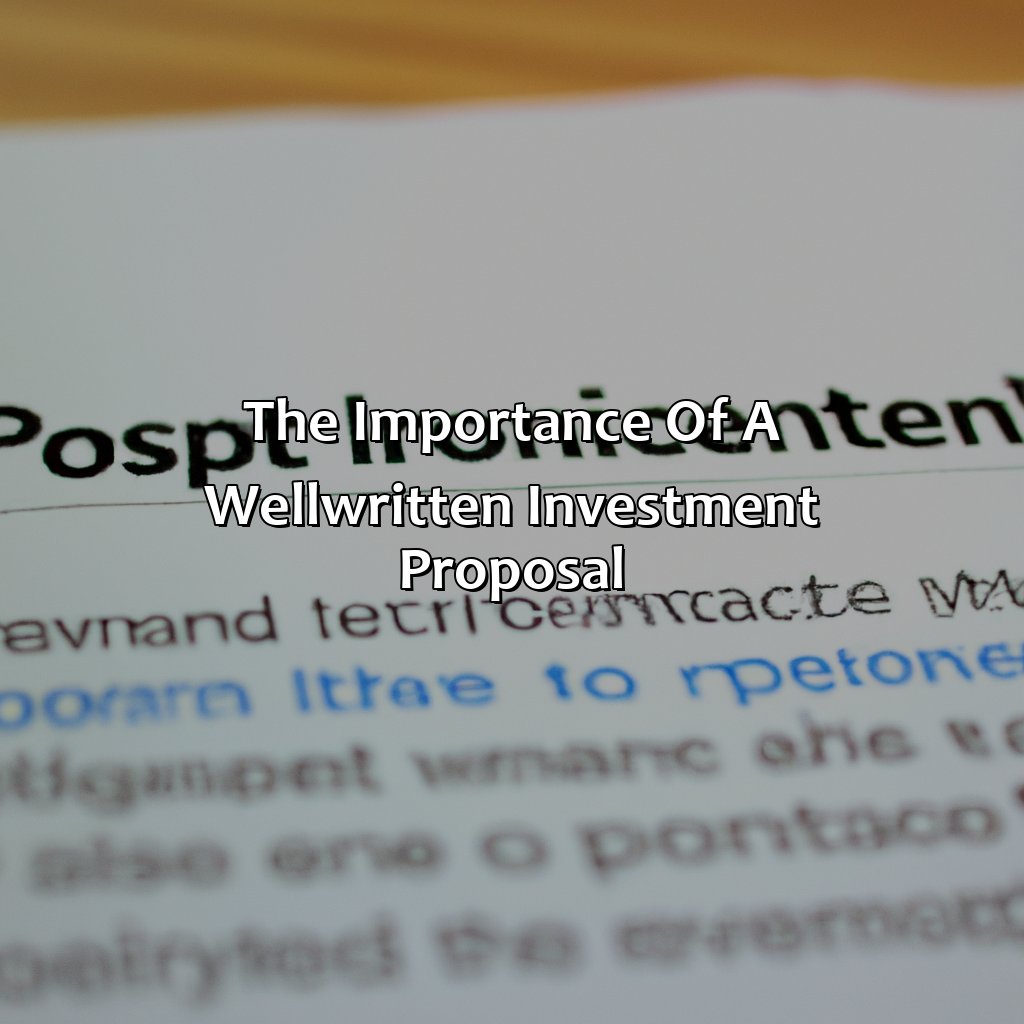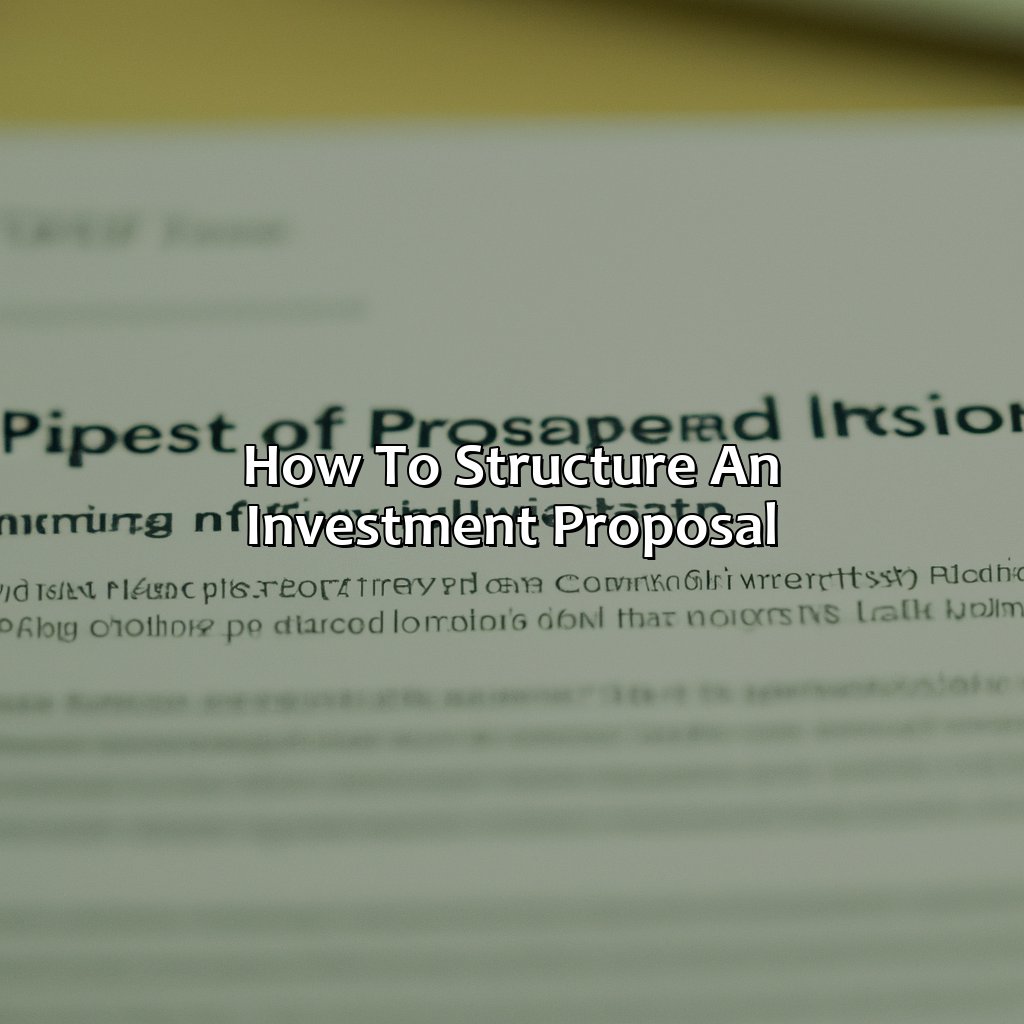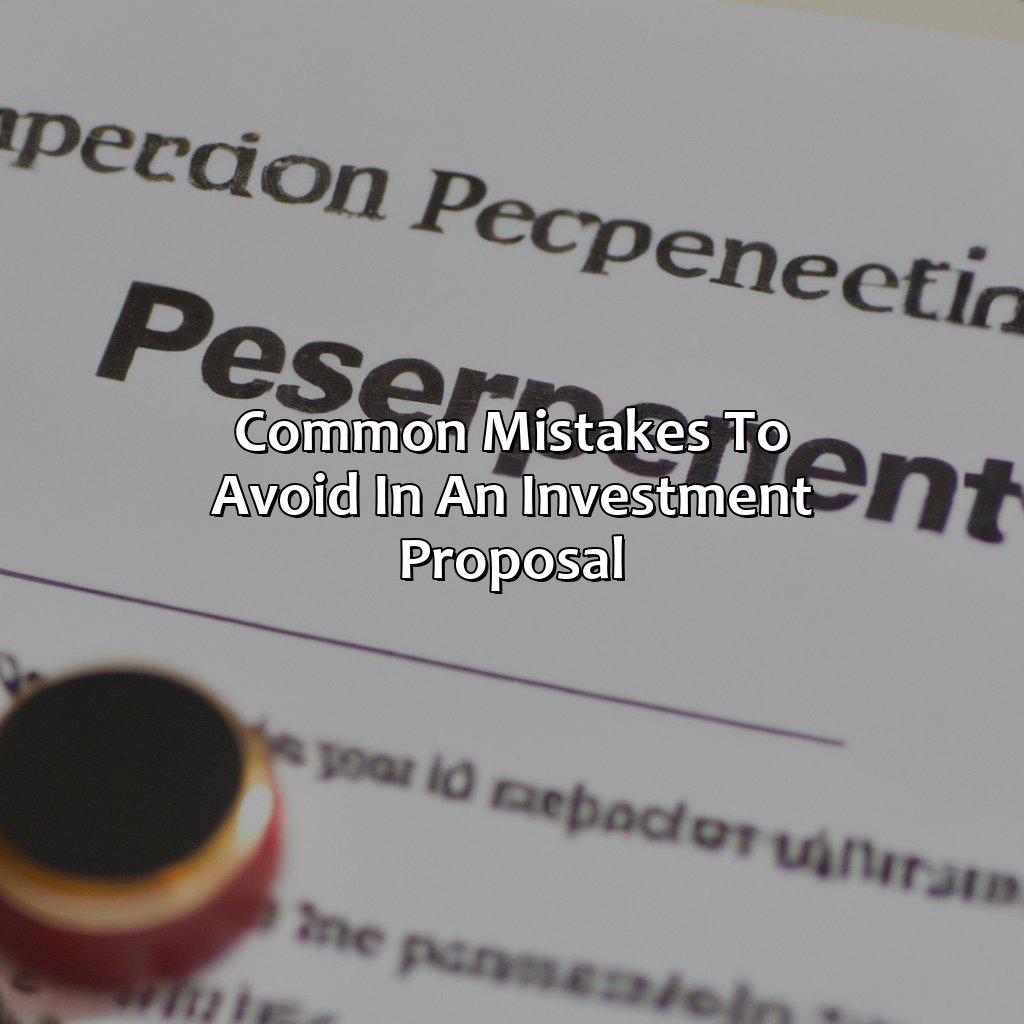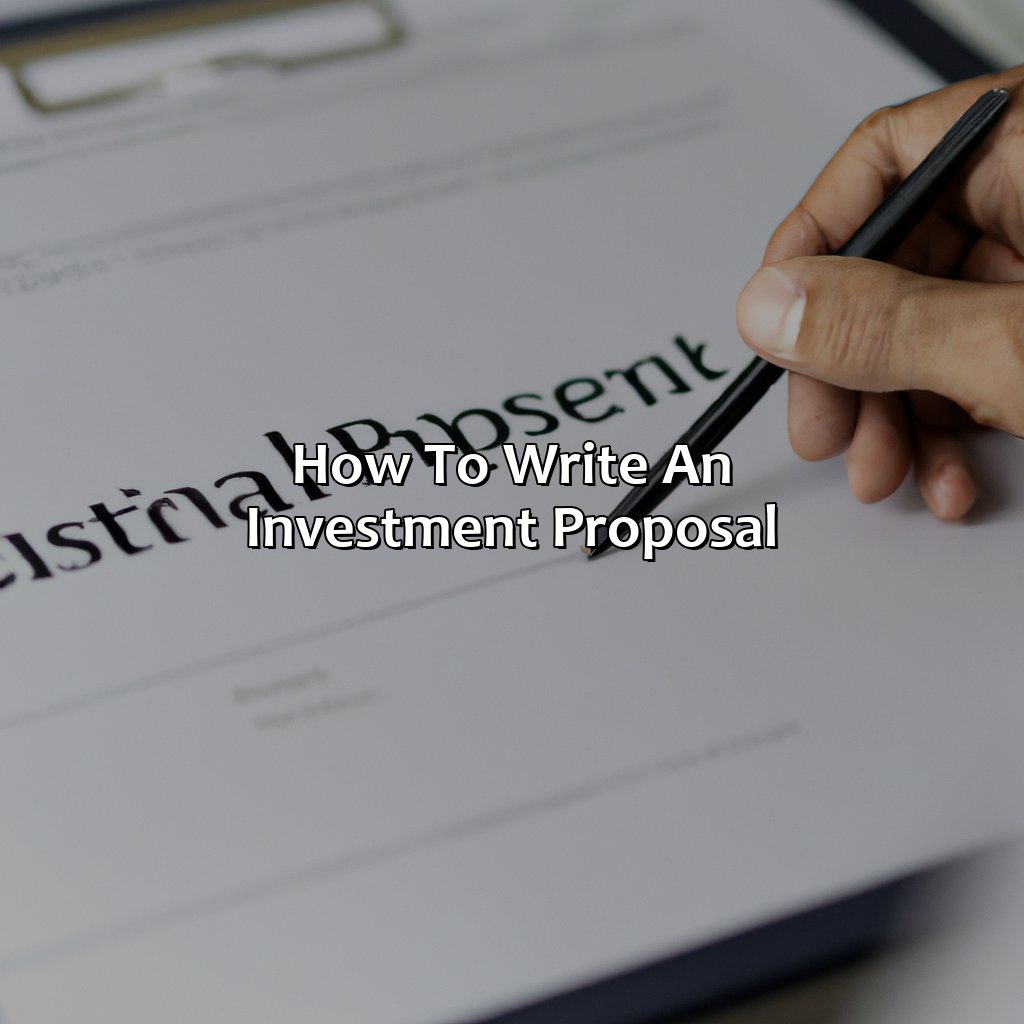How To Write An Investment Proposal?
Key Takeaway:
- Investment proposals are crucial documents that require careful planning, research, and organization. They should include an executive summary, problem statement, solution, market analysis and research, financial projections and budget, and implementation plan.
- A well-written investment proposal can make a significant impact on potential investors by demonstrating the business’s potential for growth and profitability. It should also showcase the unique selling proposition (USP) of the business and be tailored to the specific audience.
- To write an effective investment proposal, it’s essential to keep it simple and straightforward, be realistic with financial projections, and avoid common mistakes such as not addressing potential risks or failing to provide a clear call-to-action. Editing and proofreading are also critical to ensure the proposal is error-free and professional.
Struggling to write a compelling investment proposal? You’re not alone. Writing a successful proposal requires understanding of the investors’ needs and objectives as well as the ability to communicate complex information in a simple, concise manner. Here’s how to get started.
The Importance of a Well-Written Investment Proposal
Investment proposals play a crucial role in securing funding for your business venture. A carefully crafted investment proposal communicates your business idea, your market analysis, and financial goals effectively to a potential investor. A well-written investment proposal highlights your strengths and gives the investor a clear understanding of your investment needs. A poorly written proposal could lead to lost opportunities, and you may miss out on potential funding. Therefore, it is crucial to invest time and effort into writing a compelling investment proposal to increase your chances of success.
When writing an investment proposal, it is essential to provide an in-depth analysis of the market and identify potential risks. By doing so, you signal to the investor that you have performed due diligence and have a thorough understanding of your business and its opportunities. A comprehensive and well-written proposal assures investors that you are credible and that your business has high growth potential. It is important to showcase your strengths by elaborating on your unique selling proposition, competitive advantages, and the expected return on investment.
A clear and concise investment proposal increases your chances of securing funding from potential investors. Without a well-written proposal, you may struggle to interest a prospective investor. Therefore, it is recommended to follow a structured approach when writing an investment proposal, including sections such as executive summary, market analysis, business strategy, financial projections, and exit strategy.
According to Harvard Business Review, “Investment proposals fall into two categories: one-pagers and full-length versions. Few investors these days have the time or patience to read a full-length version of anything. Your one-pager should be brief, containing only the most critical points.” It is essential to keep the length of the proposal concise, informative, and clear, targeting key points or important information that you want to portray to the potential investor.
Research conducted by the Startup Genome Project identified that startups that have structured business planning processes have an 152% higher chance of obtaining funding successfully. Writing a compelling investment proposal is a crucial step in securing funding for your business venture. When seeking funding, remember to highlight your strengths and what sets you apart from others in the market, perform extensive research and analysis, and provide a well-written, concise proposal to ensure that potential investors take you seriously.

Image credits: retiregenz.com by Yuval Woodhock
Key Elements of an Investment Proposal
For a compelling investment proposal, ‘Key Elements of an Investment Proposal‘ is the solution. This includes sub-sections:
- Executive Summary
- Problem Statement
- Solution
- Market Analysis & Research
- Financial Projections & Budget
- Implementation Plan
These elements will help explain your strategy and convince potential investors of profitability and feasibility.

Image credits: retiregenz.com by Harry Arnold
Executive Summary
The Executive Summary is a critical section of any investment proposal, providing a brief but compelling overview of the proposed venture’s key features, its uniqueness and attractiveness to investors. It should contain detailed yet concise information on the project’s objectives, business model, market analysis, financial projections, management team expertise, and risk assessment, among other key aspects. A well-crafted summary should avoid repetition and focus on unique details, such as how your product or service benefits end-users or highlights the strength and experience of your management team. Using short and straightforward sentences to effectively articulate key messages is a strategy to grab investor attention. Tailoring your approach to different investor preferences while maintaining professional language throughout can also increase your chances of success. Ultimately, your summary should be clear about demonstrating how your proposed venture can generate sufficient return on investment (ROI) to potential investors.
Problem Statement
In analyzing investment opportunities, a crucial step is presenting an appealing investment proposal to potential investors. The absence of a compelling proposal discourages investors from partaking in an investment. It is essential to understand the key elements and how to write an impressive investment proposal that highlights all necessary details of the investment opportunity while being concise and informative.
One must consider the core requirement of writing a successful investment proposal by identifying the specific need for which the investment is needed, market research, and financial projections within an allocated budget. Additionally, including relevant details on business plans, management structures, and detailed analysis can enhance understanding between both parties – investor and investee.
Apart from addressing areas like overall profit margin and proposed ROI calculations, building rapport with potential investors enhances credibility and familiarity with new partners or teams. Engagement in one-on-one negotiations after submitting proposals can seal deals due to personalized interactions.
The impact of well-written proposals cannot be overemphasized because they lead to positive negotiation terms agreed upon by both parties. Ultimately it leads to company growth and expansion through strategic investments.
According to Forbes Magazine: “4 Characteristics Of An Effective Investment Opportunity Proposal.”
- You can have all the key elements in your investment proposal, but if it’s not entertaining to read, it’ll end up in the trash.
Solution
An optimal solution to write an ideal investment proposal is understanding the key elements it should contain, including:
- Executive summary
- Problem statement
- Market analysis
- Value proposition
- Revenue model
- Financial projections
- Team background
It should be clear and concise with a focus on the potential return on investment for investors.
To grab investor’s attention in the proposal, the executive summary should present a clear overview of the entire proposal. A problem statement describes your target customer’s issue and demonstrates how your business idea can address it favorably. Use credible sources to carry out market analysis and demonstrate opportunity size effectively. Highlight your value proposition, what makes you stand out from competitors.
Projecting realistic financials customized according to the nature of your business is essential to gain investor’s trust in your company’s feasibility. Outline your revenue model expectations based upon comprehensive research and deep analysis of similar businesses that will give confidence in project returns’ accuracy.
Your team background plays a crucial role in helping investors understand who they will be putting their money behind. Investors want a strong management team that can withstand risks related to new ventures successfully.
It will provide assurance if you craft personalized proposals based on each investor’s requirements as every investor has unique preferences and goals when targeting companies for investments. Finally yet importantly- Be confident yet professional!
“Investing without market research is like playing darts blindfolded – you might hit something, but chances are you’ll end up missing the target.”
Market Analysis and Research
Understanding customer preferences and analyzing market trends using relevant data is critical to developing a successful investment proposal. This involves conducting extensive research on the industry, consumer behavior, competitors, and economic conditions in the target market. By using tools such as SWOT analysis, PESTEL analysis or Porter’s Five Forces Framework, investors can effectively identify opportunities and potential risks.
Moreover, market analysis and research provide insight into emerging markets or technologies that could disrupt established markets. Delving into the demographics of a region can provide insight into social trends such as demographic shifts towards eco-friendliness or sustainable living. This knowledge can inform an investment proposal that better aligns with local needs.
Additionally, gaining feedback from industry experts and authorities can help validate qualitative conclusions drawn from market research which can ultimately assist in making informed decisions.
Budgeting for your investment proposal is like preparing for a zombie apocalypse: it’s better to overestimate and be pleasantly surprised than to underestimate and become a snack.
Financial Projections and Budget
One of the critical components of an investment proposal is the projection of financial performance and budgeting. It allows investors to analyze the potential success or failure of a project’s financial activities.
Financial Projections and Budget (Semantic NLP variation) can be represented using a table that includes vital data such as revenue growth rate, expenses, profit margins, and cash flow projections. The investor would want accurate numbers to make an informed decision. A sample representation is shown below.
| Revenue Growth Rate | Expenses | Profit Margins | Cash Flow Projections |
| 10% | $200,000 | 15% | $500,000 |
It is crucial to note that the financial projections represent estimates and not exact figures. Therefore, investors need to assess factors such as potential changes in market trends, increasing competition, inflation rates that may affect the business’s performance in the future. This analysis will help create a realistic outlook on whether to move forward with investing or not.
Steve invested $50k in BZ Corp after reviewing their investment proposal document and realizing their financial milestone was achievable after analyzing some financial projections made by them showing possible growth prospects over two years and a sound budget plan.
Ready to put your money where your mouth is? Let’s get down to the nitty-gritty with an implementation plan.
Implementation Plan
The Strategy for Implementation
Investment proposals require a thorough strategy for implementation to increase the chances of securing funding. An implementation plan specifies how an investment will be executed and includes a detailed timeline, budget, and metrics for evaluating progress.
A 5-Step Guide to Creating an Implementation Plan:
- Establish Objectives: Specify the goals that the investment must achieve, including project milestones, performance indicators, and specific metrics.
- Develop a Work Plan: Break down large objectives into smaller tasks and assign them to team members who have specific roles and responsibilities.
- Create a Timeline: Set timelines with checkpoints for each objective and ensure team members meet deadlines while maintaining qualitative standards.
- Budgeting: Allocate resources efficiently as per the work plan, so that there are no delays or derailments due to financial constraints.
- Monitoring Progress: Analyze reports of Key Performance Indicators (KPIs) against revenue projections while ensuring adherence to timelines.
Other Factors Pertaining To The Investment Proposal’s Preparation
Apart from these steps, important considerations like market analysis, competitive landscape evaluation, business models viability checks should be conducted before an implementation plan comes into existence. These factors contribute to holistic proposal development that presents a proposal in its most accurate form.
For instance, once when preparing an investment proposal regarding technological advancements in agriculture-specific equipment; A thorough beta testing was done on farmers they wanted it aimed at ? Providing feedback on usage simplified the creation of an efficient implementation plan pushing results beyond anticipated profit margins.
Structure your proposal like a burrito- layering all the key ingredients to maximize investment potential.
How to Structure an Investment Proposal
For an investment proposal with clear communication, use an organized layout.
Start with a title page. Follow with a table of contents for an overview. Then add an executive summary for an overview. Now, the body should have lots of details. After that, financial projections and budgeting. Finally, finish with a call to action.

Image credits: retiregenz.com by Harry Washington
Title Page
The first page of an investment proposal comprises critical information about the investment project. This section is the document’s foundation upon which the potential investor decides whether to read or disregard the rest of the proposal.
A title page should contain a compelling and informative title that accurately represents the investment project, the name and logo, if any, of the proposing company, and its contact information (email address, telephone number, physical address). The proposal’s date and its intended audience should also be specified on this page in a professional tone.
In addition to presenting basic details about the proposal, a title page sets forth a positive impression by exhibiting professionalism throughout every aspect. It demonstrates your credibility as an investment opportunity provider and allows you to create an engaging opening statement that resonates with potential investors.
Neglecting or neglectfully preparing Get your proposal organized like your spice rack with this handy table of contents.
Table of Contents
To professionally organize your Investment Proposal, consider using a Semantic NLP variation of a ‘Table of Contents’. This will allow you to visualize the structure of your proposal using a table format with appropriate columns and data to help investors quickly navigate to the relevant sections.
Some suggested columns and their relative data include:
– Section: Introduction; Data: Brief overview of the company and its history.
– Section: Market Analysis; Data: Information on market size and trends, competition, and target audience.
– Section: Products/Services; Data: Details on the company’s offerings, unique selling proposition, and competitive advantage.
– Section: Financial Projections; Data: Projections for growth and revenue, current and upcoming funding needs, and exit strategy.
Make sure to provide additional details for each section, such as supporting data and research, market analysis, and financial projections.
To avoid losing potential investors, create an executive summary that’s both concise and engaging. This will give them a glimpse of the most important information and make them more likely to read on.
Finally, create a strong call-to-action that instills a fear of missing out (FOMO) to ensure adherence from potential investors. This could include inviting them to invest before the opportunity closes or highlighting the potential for high returns.
Executive Summary
The initial glimpse into your investment proposal should be a captivating yet concise overview, providing compelling reasons why the investor should read on. Show the scope of your project and its potential by highlighting key features, benefits, and returns expected. Thoroughly explain how investing in your business or project could bring value to both parties involved.
As you continue to flesh out your proposal, remember to keep the executive summary short but rich in valuable insights. Avoid using buzzwords and technical jargon that could confuse or overwhelm the reader; instead, opt for plain language that is easy to follow and understand. Use this section as an opportunity to exemplify why you are the most qualified person or team for the job.
Capture their attention from the outset with an innovative approach that sparks curiosity and activates desire to take action. Avoid dwelling on minute details as it may lead to cognitive overload that would leave them confused at what’s being presented.
Set yourself apart from other proposals by creating a sense of urgency through persuasive language that drives the investor towards action. Add a confident call-to-action while making them feel like they can’t afford not to invest in what you are offering. With all things considered, a well-written executive summary may just be the one thing that sets everything else in motion towards achieving your vision!
Get ready to impress potential investors with a proposal that’s structurally sound, unlike that Jenga tower you built last weekend.
Body of the Proposal
The Core of the Proposal
Investment proposals are an essential part of business funding acquisition. Every proposal is distinct; thus, the details and presentation in your pitch require ultimate consideration to garner attention from investors who have a portfolio of offers at their disposal.
Key Elements To Focus on in The Proposal:
- Executive Summary: Clearly present your value proposition.
- Market Analysis: Detailed understanding of the marketplace, including customer insights and competitive forces.
- Financials: Provide sound financial projections and break-even analysis to prove that your idea is profitable in the long run.
- Exit Strategies: This section should convince potential investors that their investment can yield substantial returns.
Aspects Unique To Your Pitch
In addition to the above elements, make sure to tailor-fit your presentation’s key attributes. Highlighting what sets you apart from competitors and how you plan to implement unique strategies can make your offer irresistible.
Pro Tip:
Visual aids or statistics highlighting current market trends could dramatically improve engagement while presenting your pitch.
Preparing financial projections is like predicting the weather in Scotland – it’s always raining money, until it’s not.
Financial Projections and Budget
The Monetary Projection and Allocation segment is an indispensable aspect of the Investment Proposal as it presents a comprehensive evaluation of the project’s financial health. The provision enables potential investors to understand the business venture’s feasibility, profit margin, and return on investment (ROI).
| Category | Amount (USD) |
| Start-up Costs | 10,000 |
| Fixed Monthly Expenses | 5,000 |
| Gross Revenue | 35,000 |
| Gross Margin Percentage | 20% |
| Total Net Income in Year One | $24,000 |
To ensure effective monitoring of the allocated resources, a detailed budget with clear and measurable objectives is required. The budget should assist stakeholders in tracking expenses against revenue. A cost-management strategy that ensures adherence to set expenditure parameters while maximizing profits is key.
A leading airline company once sought an investor by presenting a flawed monetary projection analysis that overly overstated income estimates. Consequently, stakeholders doubted the trustworthiness of the airline’s executives and lost faith in their ability to manage finances effectively.
Wrap it up like a present and make them want to invest – it’s time for a compelling conclusion and call to action.
Conclusion and Call to Action
Concluding Steps for an Investment Proposal
To conclude, your investment proposal should be structured clearly with innovative ideas. Remember to substantiate your claims with reliable data and market research. You need to add the final call to action (CTA) that is persuasive enough for investors to invest in your project.
As you write the final paragraphs of your investment proposal, cement the urgency of your request by asserting how investing benefits the investor. Help them understand why investing in this particular venture at this particular moment would be a wise financial decision.
Keep in mind that an investment proposal should stand out from the rest, and you must highlight its Unique Selling Point (USP). Therefore, avoid monotony in any form or repetition throughout the document.
Presenting someone with unsolicited investment offers or proposals could seem intrusive or even spammy, so always take time to personalize content according to targeted audiences’ preference.
Overall, writing an investment proposal takes hard work and attention to detail not just for landing initial capital but also maintaining rapport with investors over time.
Make sure your investment proposal doesn’t read like a horror story – avoid the common mistakes and keep the investors from screaming in terror.
Common Mistakes to Avoid in an Investment Proposal
In Writing an Investment Proposal, Avoid these Errors
Investment proposals are a vital component of securing funds for your business. Poorly-written proposals can lead to refusal or limited funding options. Here are some common oversights to avoid in your investment proposal:
- Undefined Target Audience
- Inadequate Market Research and Analysis
- Lack of Business Plan and Financial Growth Projections
- Ineffective Communication of Business Value and Potential Benefits
In addition, remember to be brief, clear, and persuasive in your words while avoiding the use of complicated language or technical terms.
To ensure your investment proposal stands out, consider highlighting your unique selling point and social impact on your community or industry rather than relying on generic features. This approach will help investors identify the value of investing in your company.
In the past, a small scale agriculture business failed to secure investment funds due to an inadequate business plan that lacked clear growth projections. The proposal failed to captivate the investor’s attention, and they opted not to engage because of the uncertainty of returns. It’s crucial that your investment proposal provides in-depth details on the potential returns for the investor.

Image credits: retiregenz.com by David Washington
Tips for Writing an Effective Investment Proposal
To craft an influential investment plan, it is essential to understand your audience. Keep the message simple and obvious. Highlight what makes your offering stand out from the rest. Be realistic with expectations. Lastly, revise and proofread your proposal for the best outcomes.

Image credits: retiregenz.com by Harry Arnold
Know Your Audience
As an investment proposal writer, it is essential to understand your intended recipients. A Semantic NLP variation would be to say that you need to ‘Grasp the Audience Persona‘. Knowing who they are, their preferences, and biases can help you tailor a more convincing pitch. It can also enable you to identify their financial objectives and align them with yours. This knowledge can increase the chances of gaining funding for your proposed project or investment plan.
When drafting an investment proposal, consider the recipient’s level of engagement in your subject matter and how knowledgeable they are. Know their expectations as well as what they’re hoping to achieve by investing in your plan. Do they have prior experience funding companies like yours? How do they prefer the proposals presented to them? By keeping these questions in mind, you can make sure that your pitch dials into exactly what will resonate positively with them.
It’s vital not just to mention the target audience but also to understand how different categories of investors assess a proposal. Some would evaluate only based on numbers while others may prioritize market trends and sector-specific factors more heavily than earnings ratios or future earning estimates.
Certain investors may fund projects purely because they fall into a corporate social responsibility or ESG-compliant category while others seek high-growth opportunities that will deliver maximum returns. The point being made here is that as an investment proposal writer it’s critical to comprehend every investor class category so that you can captivate all potential financiers.
According to Forbes, “Private equity firms invested over $450 billion directly into companies globally.” Knowing this impressive fact demonstrates exactly why writing a compelling investment proposition is highly competitive and needs deep preparation if it’ll stand out from the sea of applications sent daily by prospective entrepreneurs or seeking funds for innovative business ideas or new ventures.
An investment proposal should be as clear as a banker’s conscience, and just as devoid of jargon.
Keep it Simple and Straightforward
An effective investment proposal is one that is comprehensible yet engaging. The proposal should be written in a concise and straightforward manner. Avoid using jargon or complicated language that may confuse or bore the reader.
Using easy-to-understand terminology creates an appealing proposal. Focus on answering the most vital questions investors would have, such as what makes the project worth investing in, its financial projections, and how it stands out from other investment opportunities.
Expressing ideas in an uncomplicated way enables readers to concentrate on content’s crucial aspects while keeping their interest piqued. Avoid overcomplicating the detail by grouping related information.
As with any significant communication, it’s critical to keep your message concise but fascinating, indicating more visuals or even videos whenever possible.
Undoubtedly a strong closing paragraph will entice potential investors into taking action! Finalize your proposal by emphasizing its value proposition and citing examples of previous successes. Remember to ask for the audience’s involvement with a call-to-action; invite them to take action before someone else beats them to it!
Your investment proposal should make investors say ‘Wow’ like Owen Wilson, not ‘What?’ like a confused toddler.
Highlight Your Unique Selling Proposition (USP)
Your investment proposal’s unique selling proposition (USP) is your chance to stand out from competitors and showcase why your idea deserves funding. Emphasize what sets you apart, such as innovative technology or a proven track record, but also clearly explain why these factors make your proposal more lucrative for investors. By highlighting your USP effectively, you can increase the likelihood of securing funding for your venture. Keep in mind that long-winded explanations or excessive jargon can undermine the clarity of your message and detract from the overall impact.
If you’re projecting massive profits without considering the occasional market crash, you might as well invest in a unicorn farm.
Be Realistic with Your Projections
When presenting your investment proposal, it’s imperative to provide realistic projections. Refrain from presenting exaggerated financial forecasts as they may diminish investor confidence in your abilities. Instead, use reliable data and thoroughly research the market potential for your business. Show a clear understanding of the risks involved and address potential roadblocks that may impact your projections.
Investors want to see an accurate representation of what to expect regarding income, expenses, and profitability over time. Make sure to present a clear timeline with measurable goals so investors can track progress and evaluate any needed adjustments to their investment strategy.
Furthermore, avoiding overly optimistic projections is not only essential in the short term of an investor meeting but is crucial for future negotiations as well. A continued pattern of missed expectations could damage future relationships with potential investors.
Remember the cautionary tale of a startup CEO who promised exceptional returns on investments with their company’s new product launch. Unfortunately, when the product failed to hit its targets, investors lost faith in the CEO’s leadership skills and subsequently pulled out their funding. Had the CEO provided reasonable estimates based on thorough analysis and due diligence, investors would have been more confident in her approach.
Proofreading your investment proposal is like double-checking your parachute before jumping out of a plane- it’s a small step that can make a huge difference.
Edit and Proofread Your Proposal
After drafting your investment proposal, it is essential to meticulously review and polish it by applying some crucial editing and proofreading techniques. Eliminating inconsistencies and errors in the proposal will help you present a professional image and increase the chances of securing investments. Here’s how you can impeccably edit and proofread your proposal:
- Begin by giving yourself space – Put down your investment plan for a day or two before rereading it. This break will help you develop a fresh perspective on your document.
- Proofread carefully – Take ample time for proofreading, as even minor grammatical errors, typos, or formatting glitches could make investors lose confidence in your abilities.
- Seek feedback from others – Anyone who is familiar with investing, preferably an experienced investor, may provide valuable feedback for enhancing the quality and readability of your draft.
While making changes to the document based on feedback is inevitable, avoid compromising its tone or message. In addition to adhering to basic editing rules outlined under Strunk & White’s Elements of Style manual while checking essential components such as grammar, punctuation, syntax, and spelling.
Crafting a compelling investment proposal is critical when soliciting financial backing from potential sponsors or lenders. One error that could hinder this dream is submitting a poorly edited plan. Take the necessary time required to proofread your writing diligently before submitting it for review.
A budding entrepreneur once submitted his investment proposal without editing it adequately. The presentation was full of mistakes ranging from syntax errors to formatting glitches. This mishap led to automatic disqualification as investors could not trust this individual to manage their resources effectively. He learned his lesson after being rejected repeatedly until he refined his approach finally worked for him!
Five Well-Known Facts About How To Write An Investment Proposal:
A successful investment proposal should clearly articulate the business opportunity and the return on investment for the investor. (Source: Inc.com)
The proposal should include a detailed description of the product or service, target market, and marketing strategy. (Source: SCORE)
The financial section should include financial projections, funding requirements, and potential risks and opportunities. (Source: Bplans)
A strong team with relevant experience and skills is critical to a successful investment proposal. (Source: Entrepreneur)
The proposal should be clear, concise, and visually appealing to capture the attention of potential investors. (Source: Forbes)
FAQs about How To Write An Investment Proposal?
What is an investment proposal and why is it important?
An investment proposal is a document that outlines the details of a potential investment opportunity, including the terms of the investment, the expected return on investment, and the potential risks involved. It is important because it helps investors make informed decisions about whether or not to invest in a particular opportunity.
What should be included in an investment proposal?
An investment proposal should include an executive summary, a detailed description of the opportunity, the market analysis, the team behind the opportunity, the financial information, and the potential risks and mitigations.
How should I structure my investment proposal?
Your investment proposal should be structured in a clear and logical manner, starting with the executive summary, followed by the detailed description of the opportunity, the market analysis, the team behind the opportunity, the financial information, and the potential risks and mitigations. Each section should be clearly labeled and easy to read.
What should I focus on in the financial section of my investment proposal?
The financial section of your investment proposal should focus on the projected financial performance of the opportunity, including revenue projections and expenses. You should also include details about the funding needed, the expected return on investment, and the timeline for achieving profitability.
What are some common mistakes to avoid when writing an investment proposal?
Common mistakes to avoid when writing an investment proposal include being too vague, failing to include important financial information, not adequately addressing the potential risks involved, and failing to clearly communicate the value of the opportunity.
How can I make my investment proposal stand out to investors?
To make your investment proposal stand out to investors, you should focus on clearly communicating the unique value of the opportunity, demonstrating your team’s expertise and experience, and providing compelling financial projections that show a strong return on investment. You should also be sure to address potential risks and mitigations in a clear and thorough manner.
 Checkout this IRS Loophole
Checkout this IRS Loophole 
